The Intel Skylake-X Review: Core i9 7900X, i7 7820X and i7 7800X Tested
by Ian Cutress on June 19, 2017 9:01 AM ESTBenchmarking Performance: CPU System Tests
Our first set of tests is our general system tests. These set of tests are meant to emulate more about what people usually do on a system, like opening large files or processing small stacks of data. This is a bit different to our office testing, which uses more industry standard benchmarks, and a few of the benchmarks here are relatively new and different.
PDF Opening
First up is a self-penned test using a monstrous PDF we once received in advance of attending an event. While the PDF was only a single page, it had so many high-quality layers embedded it was taking north of 15 seconds to open and to gain control on the mid-range notebook I was using at the time. This put it as a great candidate for our 'let's open an obnoxious PDF' test. Here we use Adobe Reader DC, and disable all the update functionality within. The benchmark sets the screen to 1080p, opens the PDF to in fit-to-screen mode, and measures the time from sending the command to open the PDF until it is fully displayed and the user can take control of the software again. The test is repeated ten times, and the average time taken. Results are in milliseconds.
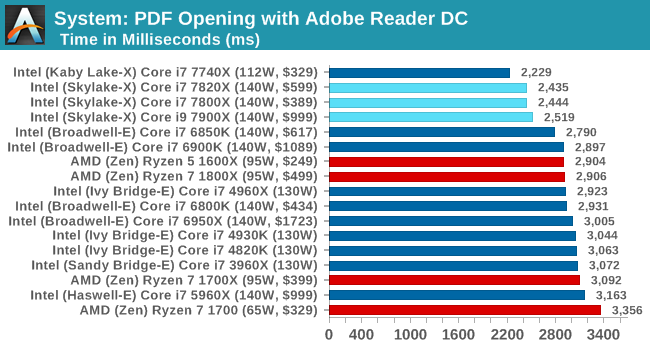
The extra frequency of the new processors is helping when it comes to opening our monster PDF, but also the extra L2 cache is likely having an effect as well.
FCAT Processing
One of the more interesting workloads that has crossed our desks in recent quarters is FCAT - the tool we use to measure stuttering in gaming due to dropped or runt frames. The FCAT process requires enabling a color-based overlay onto a game, recording the gameplay, and then parsing the video file through the analysis software. The software is mostly single-threaded, however because the video is basically in a raw format, the file size is large and requires moving a lot of data around. For our test, we take a 90-second clip of the Rise of the Tomb Raider benchmark running on a GTX 980 Ti at 1440p, which comes in around 21 GB, and measure the time it takes to process through the visual analysis tool.
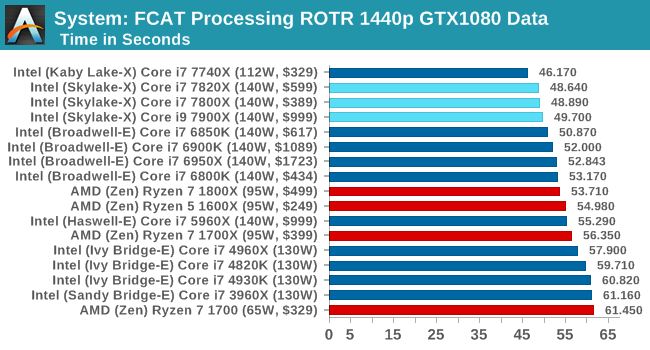
FCAT takes in a frame, processes it and dumps it, all on a single thread. The quicker you get through the workload the better, and frequency is supreme, hence we get the 7820X followed by the 7800X then the 7900X. Even though the 7900X has the higher turbo here, the results are with the margin expected.
3D Particle Movement v2.1
This is the latest version of the self-penned 3DPM benchmark. The goal of 3DPM is to simulate semi-optimized scientific algorithms taken directly from my doctorate thesis. Version 2.1 improves over 2.0 by passing the main particle structs by reference rather than by value, and decreasing the amount of double->float->double recasts the compiler was adding in. It affords a ~25% speed-up over v2.0, which means new data.
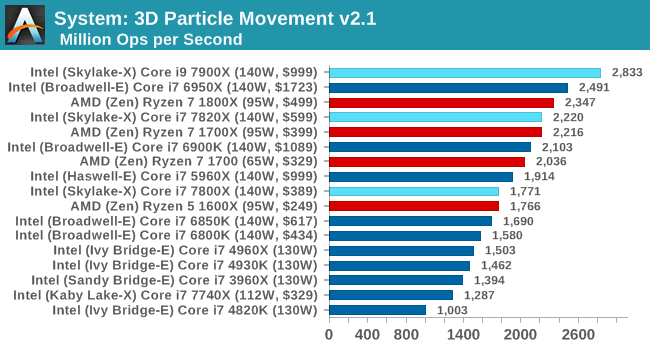
Give 3DPMv2.1 some cores, and it will show you the world / some numbers. The 1800X and 6950X were gunning for top spot, but the extra frequency of the 7900X wins here.
DigiCortex 1.20
Despite being a couple of years old, the DigiCortex software is a pet project for the visualization of neuron and synapse activity in the brain. The software comes with a variety of benchmark modes, and we take the small benchmark which runs a 32k neuron/1.8B synapse simulation. The results on the output are given as a fraction of whether the system can simulate in real-time, so anything above a value of one is suitable for real-time work. The benchmark offers a 'no firing synapse' mode, which in essence detects DRAM and bus speed, however we take the firing mode which adds CPU work with every firing.
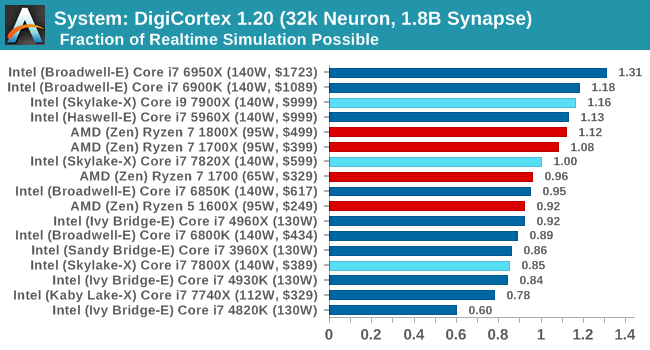
DigiCortex loves a bit of memory, although when speaking with the developer, there can some instances where the beast needs to be fed. Losing the inclusive L3 might be a factor here, especially with the 7800X all the way down.
Agisoft Photoscan 1.0
Photoscan stays in our benchmark suite from the previous version, however now we are running on Windows 10 so features such as Speed Shift on the latest processors come into play. The concept of Photoscan is translating many 2D images into a 3D model - so the more detailed the images, and the more you have, the better the model. The algorithm has four stages, some single threaded and some multi-threaded, along with some cache/memory dependency in there as well. For some of the more variable threaded workload, features such as Speed Shift and XFR will be able to take advantage of CPU stalls or downtime, giving sizeable speedups on newer microarchitectures.
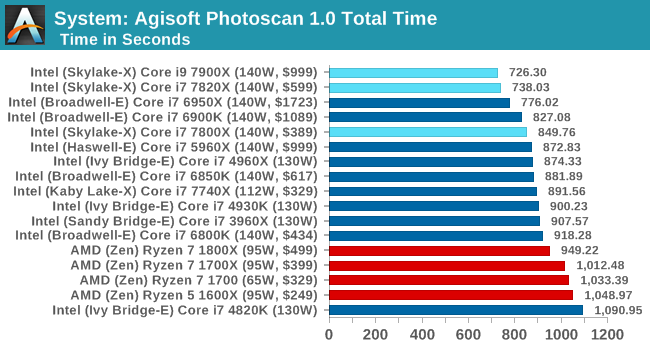
Photoscan is a mixed bag of operations, going through single thread sections to multithread and a range of cache/memory bandwidth requirepements. There's not much difference between thw 10 core and the 8 core, but the frequency helps against Broadwell-E.










264 Comments
View All Comments
Ian Cutress - Monday, June 19, 2017 - link
We didn't post gaming data in our launch Ryzen 7 review for the same reason. You are applying double standards.http://www.anandtech.com/show/11170/the-amd-zen-an...
melgross - Monday, June 19, 2017 - link
Man, another guy who didn't actually read the article, but reads other poster's remarks who also didn't read the article. Can't we just deleted these jerks remarks?koomba - Thursday, July 6, 2017 - link
Please go back and tag my reply on page 7. Short version: you are wrong, they did NOT do gaming benchmarks on their launch Ryzen review either.So quit whining about something that DIDN'T HAPPEN and using it as a weak excuse to bash this site. Your blatant AMD fan boy agenda is pathetic.
nicolaim - Monday, June 19, 2017 - link
Typos. Second table on first page says i7 instead of i9.nicolaim - Monday, June 19, 2017 - link
And incorrect MSRP for Ryzen 7 1800X.Ryan Smith - Monday, June 19, 2017 - link
Please be sure to reload. Both of those issues on the first page were corrected some time ago.Bulat Ziganshin - Monday, June 19, 2017 - link
I have predicted details of AVX-512 implementation 1.5 years ago when SKL-S microarchitecture was described in Intel optimization manual. These are details:http://www.agner.org/optimize/blog/read.php?i=415#...
Einy0 - Monday, June 19, 2017 - link
Very disappointed that AT did not publish game benchmarks because they didn't show Intel in the best light but had no problem making a big deal about Ryzen's gaming issues. This isn't the brand of journalism that Anand built this site on. It's certainly not what attracted me to the site and has had me coming back for 20 years. I come for unbiased straight shooting PC technology reviews. Now we get a mobile focus and biased PC hardware reviews. Not to mention the full screen popup ads and annoying hover ads that refuse to go away. How far the mighty have fallen!Ian Cutress - Monday, June 19, 2017 - link
We never posted Ryzen 7 gaming benchmarks in our launch review for the same reason. Please go back and check:http://www.anandtech.com/show/11170/the-amd-zen-an...
melgross - Monday, June 19, 2017 - link
You know, it almost doesn't pay to respond to these guys. They're AMD fanboys who are too lazy to read the article first, and they won't read your link either, because they don't want to. They want to believe what they say, no matter what.